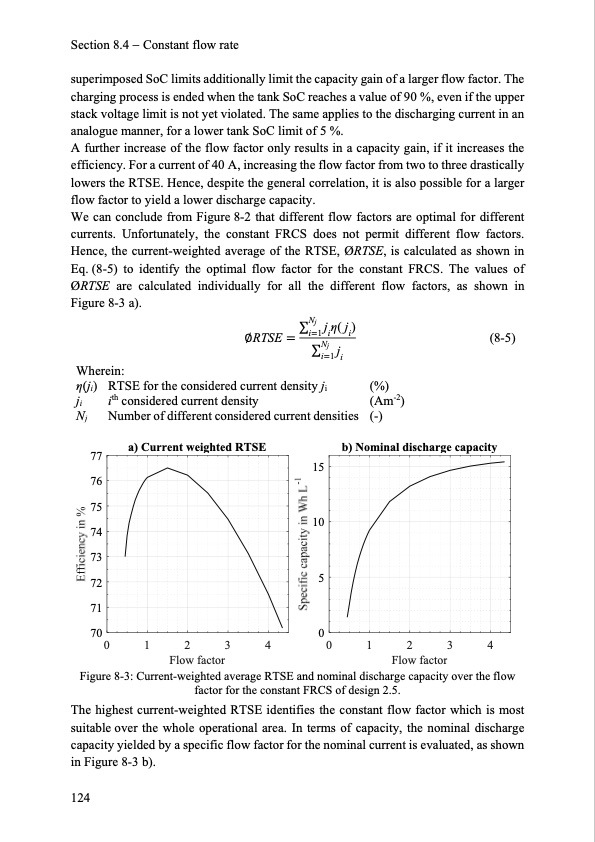
PDF Publication Title:
Text from PDF Page: 132
Section 8.4 Constant flow rate superimposed SoC limits additionally limit the capacity gain of a larger flow factor. The charging process is ended when the tank SoC reaches a value of 90 %, even if the upper stack voltage limit is not yet violated. The same applies to the discharging current in an analogue manner, for a lower tank SoC limit of 5 %. A further increase of the flow factor only results in a capacity gain, if it increases the efficiency. For a current of 40 A, increasing the flow factor from two to three drastically lowers the RTSE. Hence, despite the general correlation, it is also possible for a larger flow factor to yield a lower discharge capacity. We can conclude from Figure 8-2 that different flow factors are optimal for different currents. Unfortunately, the constant FRCS does not permit different flow factors. Hence, the current-weighted average of the RTSE, ØRTSE, is calculated as shown in Eq. (8-5) to identify the optimal flow factor for the constant FRCS. The values of ØRTSE are calculated individually for all the different flow factors, as shown in Figure 8-3 a). (8-5) Wherein: η(ji) RTSE for the considered current density ji (%) ∅RTSE i1i ∑Nj j i ith considered current density Number of different considered current densities (-) ji Nj Figure 8-3: Current-weighted average RTSE and nominal discharge capacity over the flow factor for the constant FRCS of design 2.5. The highest current-weighted RTSE identifies the constant flow factor which is most suitable over the whole operational area. In terms of capacity, the nominal discharge capacity yielded by a specific flow factor for the nominal current is evaluated, as shown in Figure 8-3 b). 77 76 75 74 73 72 71 b) Nominal discharge capacity 0123401234 Flow factor Flow factor a) Current weighted RTSE ∑Nj jη(j) i1 i (Am-2) 15 10 5 70 0 124PDF Image | Model-based Design Vanadium Redox Flow Batteries

PDF Search Title:
Model-based Design Vanadium Redox Flow BatteriesOriginal File Name Searched:
10-5445IR1000070670.pdfDIY PDF Search: Google It | Yahoo | Bing
Salgenx Redox Flow Battery Technology: Salt water flow battery technology with low cost and great energy density that can be used for power storage and thermal storage. Let us de-risk your production using our license. Our aqueous flow battery is less cost than Tesla Megapack and available faster. Redox flow battery. No membrane needed like with Vanadium, or Bromine. Salgenx flow battery
| CONTACT TEL: 608-238-6001 Email: greg@salgenx.com | RSS | AMP |